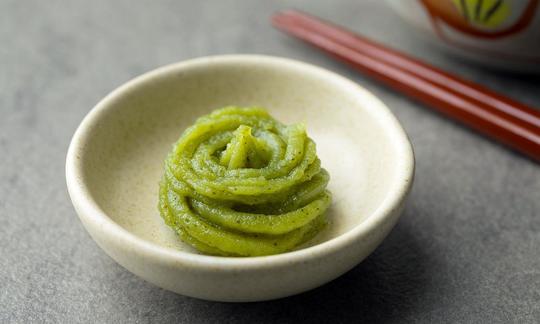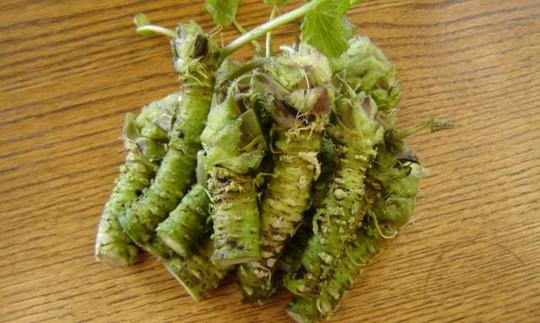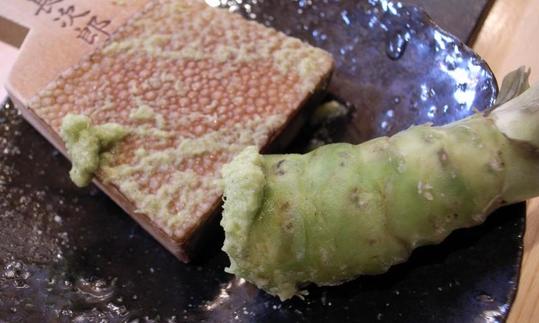Table of contents
Wasabi ( Eutrema japonicum) is the Far Eastern counterpart to horseradish and is also known as Japanese horseradish, green horseradish or water horseradish. In addition to the rhizome (colloquially known as wasabi root), the leaves, flowers and stems are also edible raw.
Use in the kitchen:
In Japan, fresh wasabi roots with their typically green color are traditionally served grated or made into a paste as a seasoning for sushi or sashimi (a popular way of preparing raw fish and seafood). The powdered rhizome is used to make a paste to season various dishes with meat, fish, noodles and rice, or it is mixed with other ingredients to make a sauce. Sweet or salty wasabi also tastes good with fruit or vegetables such as mango, pineapple, peach, apricot, cucumber and avocado. 1 Even the popular wasabi nuts can be prepared at home in no time at all. To do this, you roast nuts or seeds together with finely grated pieces of wasabi.
A Japanese marinade called "wasabi-zuke" can be made from the leaves and flowers. 1 The stems, leaves and flowers, which can be picked all year round, can also be processed into a relatively mild wasabi paste. To do this, chop 50 g of the green ingredients into small pieces and puree them in a blender together with a tablespoon of rice vinegar, a pinch of salt and a little water to create a homogeneous paste.
How hot is wasabi? Wasabi freshly prepared from the root is the hottest. Dry powder is also hot, but the spiciness only develops a few minutes after it has been mixed with water. 2 Wasabi should never be cooked, as it will lose its aroma and spiciness. It should be noted that the spiciness of wasabi evaporates much more quickly than that of horseradish. Wasabi loses a lot of its spiciness after just half an hour due to the oxidation of the mustard oils.
What does wasabi really taste like? The spiciness of wasabi develops primarily in the throat and nose. In addition to the spiciness, wasabi has a characteristic fresh aftertaste and a subtle sweetness.
How do you make wasabi? If you have the rare and valuable wasabi root, you should wash it thoroughly under cold water before using it and remove any black spots. You should avoid peeling it, as most of the flavors are in the outer skin. After washing, pat the wasabi dry and grate it freshly on a very fine grater.
Recipe for vegan lime-wasabi dip:
Mix two cups of vegan sour cream with the following ingredients: juice and finely grated zest of half an organic lime, a handful of chopped fresh mint leaves, a freshly crushed garlic clove and a teaspoon of wasabi paste. Season to taste with salt andpepper.
Recipe for pea and potato puree with avocado and wasabi:
For four people, cook 500 g of floury potatoes in salted water for about 30 minutes. Add fresh or frozen peas during the last 5-10 minutes of cooking. After draining, mash the potatoes with the peas and add 150 to 250 ml of hot plant-based drink (e.g. soy milk) as needed. Mix in finely chopped spring onion, a teaspoon of wasabi and half an avocado, mashed until smooth. Finally, season to taste with salt, pepper and a little lemon zest.
| Not only vegans or vegetarians should read this: Vegans often eat unhealthily. Avoidable nutritional errors. |
Purchasing - where to buy?
In Europe, wasabi is available as freeze-dried powder in jars and cans, which you mix with water. There is also a second, lower quality of wasabi powder, which is obtained from the lower leaf stalks and the uppermost parts of the rhizome. Wasabi paste in small tubes or grated and frozen is also available. In German-speaking countries, processed wasabi products are available in most well-stocked organic shops and supermarkets or from major retailers such as Lidl, Aldi, Edeka, Rewe, Migros, Coop, Spar, Denner, Volg or Hofer.
Paste and powder made from real wasabi can be found in stores under the names Nama Wasabi (生わさび, "fresh wasabi") or Hon Wasabi (本わさび, "real wasabi"). A powder labeled Hon-Wasabi Shiyo must contain at least 50% real wasabi. Seiyō Wasabi is a mostly colored wasabi surrogate (substitute food) made from horseradish or a horseradish-mustard mixture. 2
You can only buy freshly imported wasabi in specialty shops. The plant is now also available in well-stocked garden centers or online. Fresh plants are differentiated according to origin and variety (e.g. Darum or Satsuma). The better quality either grows wild in shallow, cool and mineral-rich mountain streams or is grown in hydroponics (沢わさび Sawa Wasabi, "stream wasabi"). "Hill wasabi" (丘わさび Oka Wasabi) or "field wasabi" (畑わさび Hata Wasabi) are of inferior quality. 2
According to the DLG ( German Agricultural Society), the price per kilo of wild-growing wasabi roots is around 150 euros. In Asian shops or online shops, however, you can generally expect prices of up to 400 euros per kilo of fresh wasabi roots.
Found in the wild - Season:
The 20-60 cm tall wild plant is found in the wild mainly in its native Japan, in swampy terrain on the edge of rivers. 2 There are only a few places in the world where wasabi can grow naturally. In addition to Japan, these include the Pacific Northwest and the Blueridge Mountains in the eastern USA.
Wasabi is a perennial, herbaceous plant with strong, creeping rhizomes and upright shoots. The wild plant can be recognized by its long-stemmed, kidney-shaped leaves, up to 15 cm wide. In spring, wasabi bears clusters of small, white, four-petaled flowers. 1
Season: Leaves, stems and flowers can be harvested all year round, while the rhizome is dug up in spring or autumn. There is no known danger of confusion with poisonous plants.
Storage:
Fresh wasabi can be kept in the refrigerator for up to four weeks. Place the rhizome in a glass and cover it with water up to the base of the stem. Wrap cut wasabi in a clean, damp cloth. The rhizome can also be frozen, which increases its shelf life to around eight weeks.
Tubes and jars of wasabi paste should be closed immediately after opening and stored in the refrigerator. Wasabi powder that is mixed with water is sensitive to moisture. It should therefore be stored in airtight containers or jars with screw caps.
Already mixed powder or freshly grated wasabi lose their flavor after just half an hour because the mustard oils are very sensitive to oxidation.
Ingredients - nutritional value - calories:
Wasabi contains sulfur glycosides, which are responsible for the characteristic burning sensation. 1 Previously also known as mustard oil glycosides, these glucosinolates are sulfur and nitrogen-containing compounds. The activation to isothiocyanates occurs through the enzyme myrosinase, in which a part of the molecule chemically bonds with one or more sugar molecules. When the plant tissue is damaged, the enzymes, which are spatially separated from the glycosinolates, are released. These enzymes activate the bound mustard oils, which are the actual effect of the glycosinolates. 3,4 Wasabi contains the two mustard oils glucocochlearin and sinigrin, the latter of which is also found in mustard and horseradish. 5 Detailed information on vitamins and minerals can be found below in the USDA (United States Department of Agriculture) nutrient tables.
Health aspects - effects:
The intestines and skin can absorb the mustard oils, which have a variety of effects in the body. The enzymatic degradation products such as isothiocyanates have shown anti-carcinogenic effects in studies. Clinical studies have shown that isothiocyanates influence the metabolism of the body's own estrogens. This may mean that they can protect against estrogen-related types of cancer. Isothiocyanates also have antimicrobial effects. Benzyl isothiocyanate is also considered an effective antibiotic against bacteria and fungi. 6
Wasabi has numerous health benefits when used sparingly. However, we believe it is misleading to call it a superfood.
Dangers - intolerances - side effects:
Generally speaking, wasabi should only be consumed in moderation, as excessive consumption can irritate the mucous membranes, eyes and respiratory tract and lead to mouth pain. Wasabi is not suitable for children due to its spiciness. 3 People with stomach problems should be particularly careful, as spicy food can lead to stomach pain, heartburn or diarrhea. 5
Isothiocyanates are potentially goitrogenic substances that can promote the formation of goiter. Long-term, unphysiologically high consumption of, for example, cabbage, mustard or horseradish, which cannot be achieved through diet alone, could theoretically lead to iodine deficiency goiter. However, no goiter has been identified to date that is associated with the consumption of brassica vegetables. 6
Use as a medicinal plant:
Wasabi has warming and digestive properties and is used internally for fish poisoning. 6 In addition to the antitumor and antimicrobial properties of wasabi, scientific studies have also identified platelet aggregation-inhibiting and antioxidant effects. 3
Occurrence - Origin:
Japan is considered the only natural home for wasabi. Under perfectly adapted conditions, wasabi is now also grown as a crop in other parts of the world, for example in Taiwan, Korea, Israel, Thailand and New Zealand. 2
Growing your own in the garden or as a potted plant:
Wasabi is generally considered to be one of the most difficult plants to grow. It requires moist to wet soil for cultivation. Wasabi is best cultivated in clear, running spring water at 10-15 °C in partial shade. 1 The demanding cultivation of wasabi is unnecessary in Europe, as it is very susceptible to disease when cultivated in fluctuating conditions and in large quantities.
If you are a hobby gardener and want to grow wasabi, you should try to imitate the natural environment in which wasabi grows best. In addition to high humidity and well-moistened soil, it is important that the water can drain well from the soil. The soil must not be waterlogged or muddy. Ideally, wasabi should be planted near a natural pond or stream, as the soil is constantly moist. Near a waterfall is also a suitable place, as the plant receives water evenly through spray. 7
The temperature should not be below 7 or above 21 °C. Wasabi needs a very shady place and does not feel comfortable in direct sunlight. In the garden, wasabi should be planted under trees or shaded with a canopy. In its artificial environment, wasabi needs soil with a pH value of six to seven. This can be achieved by using a mixture of organic and sulphurous fertilizer. 7
Since Wasabi is only partially hardy, the plant needs to be covered in winter. As a potted plant, Wasabi is best overwintered in a frost-free place indoors, in an unheated greenhouse or in a conservatory. 2
It can take 15 to 24 months before the rhizomes are harvested for the first time. The roots are then about 15 cm deep. In spring or autumn, the rhizomes and roots are taken out of the pot and the substrate is removed. Leaves, stems and flowers can be harvested all year round.
Propagation can be done by dividing the rhizomes. The rhizome pieces are placed in separate pots and cultivated like the mother plant. Wasabi is not considered a food plant for bees.
General information:
The Wasabi genus ( Wasabia japonica or Eutrema japonicum syn. Eutrema wasabi) includes a total of two perennial species. They come from the family Brassicaceae. 2
What is a wasabi? Strictly speaking, the colloquial term "wasabi root" does not refer to a root, but to a special form of underground stem, namely a rhizome. Rhizomes are used for vegetative propagation and for storing reserve substances. Although they look like roots, like ginger, they form leaf scars and do not have any root characteristics. 8
Why is wasabi green? Real Hon-Wasabi is actually grey to mint green. The typical green colour of the wasabi pastes available in Europe is often due to the addition of chlorophyll or the algae spirulina.
Alternative names:
Wikipedia knows these German names for wasabi: Japanese horseradish, green horseradish or water horseradish.
Literature - Sources:
Bibliography - 8 Sources (Link to the evidence)
| 1. | Bown D. Kräuter. Die grosse Enzyklopädie. Anbau und Verwendung. 2. Auflage (2015); Dorling Kindersly Verlag GmbH. München. |
| 2. | Wikipedia Wasabi. |
| 3. | Pharmawiki.ch Wasabi. |
| 4. | Fleischhauer SG, Guthmann J, Spiegelberger R. Enzyklopädie. Essbare Wildpflanzen. 2000 Pflanzen Mitteleuropas. 1. Auflage (2013); AT Verlag. Aarau. |
| 5. | Gesundheit.de Wasabi: Scharfes aus Japan. |
| 6. | Leitzmann, Müller, Michel, Brehme, Triebel, Hahn, Laube. Ernährung in Prävention und Therapie. 3. Auflage. Stuttgart; 2009. Hippokrates Verlag. |
| 7. | Wikihow Wasabi anpflanzen. |
| 8. | Wikipedia Sprossachse. |












Comments